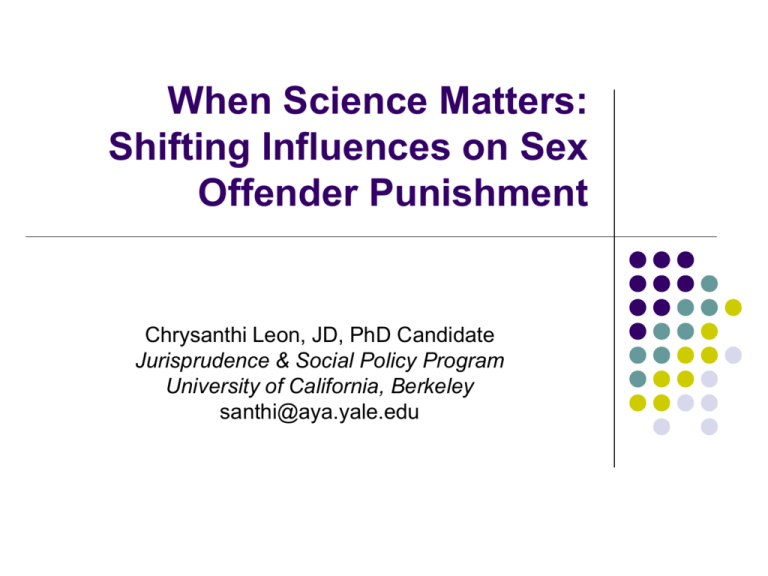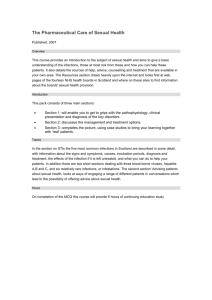
When Science Matters:
Shifting Influences on Sex
Offender Punishment
Chrysanthi Leon, JD, PhD Candidate
Jurisprudence & Social Policy Program
University of California, Berkeley
santhi@aya.yale.edu
I. Grounding theories of contemporary
penality through historical comparison
II. Ch. 1 The Sexual Psychopath Era:
A. Panic & Policy
B. Mediating Punitiveness
Scholar
Input
Key mechanism
Output
Garland
Social structure
and politics (late
modernity)
Erosion of penalwelfare model
Mass
imprisonment,
punitive politics;
Zimring
Vengeful public,
distrust of experts
Policy-makers
lose insulation
Direct democ.
control of pun.
Tonry
War on Poverty
Fails
Cycles of
Punitiveness
Increasing Incarc
of Drug Offenders
Simon
Policy-makers
react to fear of
crime
Breakdown of
social activiststyle of gov’ing
Detention and
Segregation;
Gov’ing Thru
Crime
Wacquant
Neo-liberalism
Race acted on
Prison society
through the prison
and ghetto
The Mystery:
CA 8.00
Sex Offense Prison
Admissions
7.00
Value ALLSEXRATE
6.00
5.00
From 1940 to 1971,
48% decrease
From 1971 to 1984,
486% increase
4.00
3.00
2.00
1.00
Missing
2001
1998
1995
1992
1989
1986
1983
1980
1977
1974
1971
1968
1965
1962
1959
1956
1953
1950
1947
1944
1941
1938
1935
1932
Year
The Project
Intellectual and Legal
History, 1930-present
• Caselaw and legislation
(California)
• News Media
• Theory and Research
(Psych, Crim and Soc)
• Longitudinal Prison
Admissions Data
California case study
• Interviews with law
enforcement and
treatment professionals
• Participant Observation
in state-wide coalition
on sexual offending
Knowledge and Practice in
Three Eras
Sexual Psychopath Era,1930-55:
dominated by a notion of criminality
Therapeutic Optimism, 1955-80:
dominated by an ideology
Containment Era, 1980-present:
dominated by a practice
The Sexual Psychopath Era:
Findings
Beliefs—the media constructs, fringe experts
confirm, and law refers to a monstrous sex
fiend, plagued by uncontrollable desires who
must be captured.
Strategies—Gov’t responds, first with policies
based on incapacitation, then research/
treatment emphasis.
Prison—No Significant change, despite sexual
psychopath laws.
The Sexual Psychopath Era
Conclusions: Conflicts Deflect
Punitiveness
Criminological Expertise: Fringe vs.
Mainstream; Mainstream moves on.
Construction of Monstrous Offender (by
media and fringe experts) vs. Neighborhood
Crank/Regular Guy
“the most notorious that have occurred within the state of
California in recent years…
…received so much newspaper publicity and were so
much the subject of general conversation …
..unbelievable that any person who had
read the newspapers at all, or who had indulged in
ordinary conversation with his neighbors or friends, was
not made familiar with the details of the atrocities
perpetrated in each of those cases.”
People v. Adams, 1939 at 163.
Glucoft Murder & Its Influence:
Edwin Sutherland
a crackdown on strip clubs
strict enforcement of registration laws
a $50,000 apportionment to a sex offender
clinic, and
the creation of a coordinated detail on sex
offenses in the LAPD.
Cesare Lombroso, Criminal Man:
Criminality as Biology
“Some sex crimes are caused by
congenital tendencies in born rapists
with a cretinal diathesis that either
stimulates the genitals or provokes
insanity.”
Public Opinion:
Biology/Incapacitation
“When I read accounts of a sex crime I
am again amazed at the stupidity of
the public in general and the
lawmakers in particular.
Surely everyone knows that there is a
cure for the sex maniac… any surgeon
can do it in a few minutes.”
N. K. Randolph, MD, 1949
Gov. Earl Warren’s Conference,
1949:
Policy-makers Respond
“the public is aroused and it has a
right to expect action. He asked
for special consideration of ways
of halting attacks on little children”
Key Events in the SP Era
1934: APA Section on
Forensic Psychiatry
1937: Natl Cmte for
Mental Hygiene "The
Challenge of Sex
Offenders"
1937: MI sp law (later
found unconst)
1938: IL sp law
1939: CA sexual
psychopath law
1947: Sex offender
Registration Law (CA)
1950: Sexual
Deviation Research
Act (CA)
The Mystery Revisited:
Flat Sex Offense Incarceration Rates
During the Sexual Psychopath Era
3
2.5
2
1.5
1
0.5
0
1930
1935
1940
Rape
1945
Other Sex
1950
1955
Mediating Public Punitiveness
“People who are so incensed today and who
are urging drastic measures like castration for
sex criminals, are the same ones who in a
couple of years will be importuning us to
quash a case against some pillar of the
community-- some churchman or kindly old
grandfather.”
LAPD Officer, 1949
Snapshot of LA County: 1949
3000
arrested for child
molestation
most often charged as
misdemeanor – six months
probation
1078 “imprisoned”– 281 enter
prison
“a little, high-domed
man… admits
molesting more than
100 little girls”
Theories of penality
require historical
comparative research
Public anxiety is a necessary
but insufficient condition for
increasing incarceration.



